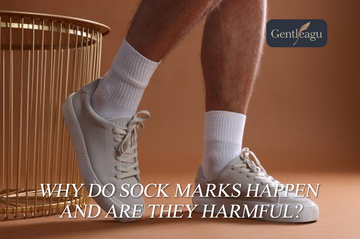Why Do Sock Marks Happen and Are They Harmful?
Sock marks occur when the elastic bands of socks press into the skin, leaving temporary impressions around the ankle, calf, or foot. While generally harmless, they can sometimes indicate issues like circulation problems, swelling, or improperly fitting socks. Understanding why sock marks happen and how to address them can help maintain foot comfort and health.
Why Do Sock Marks Happen?
Sock marks are caused by the pressure of elastic bands on the skin, especially after prolonged wear. Factors contributing to sock marks include:
- Elastic Pressure: Socks are designed to stay in place, but tight elastic bands can press into the skin, causing visible indentations.
- Improper Fit: Socks that are too small or tight can create more pressure, leading to deeper marks.
- Swelling: Natural foot swelling throughout the day increases pressure against the socks, making marks more noticeable.
- Duration of Wear: Wearing socks for long periods intensifies the pressure and leads to more prominent marks.
- Sensitive Skin: Individuals with delicate or sensitive skin are more prone to noticeable marks.
Are Sock Marks Harmful?
Most sock marks are harmless and fade quickly after the socks are removed. However, there are situations where they could signal an underlying issue:
When Sock Marks Are Harmless:
- Temporary indentations that disappear within minutes or hours are normal.
- Marks caused by mild elastic pressure, especially with snug-fitting socks, usually don’t pose a health risk.
When Sock Marks Could Be a Concern:
- Persistent Marks: If marks remain for several hours or are accompanied by swelling, it could indicate circulation issues or fluid retention.
- Pain or Numbness: Tight socks may restrict blood flow, causing discomfort or tingling.
- Skin Irritation: Prolonged pressure from tight elastic bands can irritate the skin, leading to redness or rashes.
- Underlying Health Conditions: Conditions like diabetes, venous insufficiency, or heart disease can make you more susceptible to circulation-related issues, making sock marks a potential red flag.
How to Prevent Sock Marks
-
Choose Non-Binding Socks
Opt for socks with non-restrictive elastic or no elastic at all, such as diabetic socks. These reduce pressure on the skin and prevent marks. -
Ensure Proper Fit
Wear socks that match your foot and leg size. Ill-fitting socks (too small or too tight) are more likely to cause discomfort and leave marks. -
Opt for Softer Materials
Look for socks made from breathable, stretchy materials like bamboo, cotton blends, or merino wool. These fabrics are gentle on the skin and provide better comfort. -
Avoid Long Periods of Wear
Remove socks periodically during the day to relieve pressure and allow your skin to breathe, especially if you spend long hours sitting or standing. -
Be Cautious with Compression Socks
Ensure compression socks are properly fitted to provide even pressure without being too tight. Improperly fitted compression socks can worsen swelling and circulation problems.
When to Seek Medical Attention
Consult a healthcare provider if you notice:
- Deep, persistent sock marks that do not fade.
- Swelling, pain, or numbness in the feet or legs.
- Redness, rashes, or broken skin around the sock line.
- Symptoms of circulatory issues, such as cold or discolored feet.
These signs may indicate underlying conditions like lymphedema, venous insufficiency, or heart problems that require medical evaluation.
Final Thoughts
Sock marks are usually harmless and a common result of elastic pressure. However, persistent or painful marks could signal an issue with circulation, swelling, or ill-fitting socks. Choosing the right socks—those with non-binding tops, soft materials, and a proper fit—can minimize sock marks and promote foot health.
Shop Non-Binding, Comfortable Socks to keep your feet healthy and prevent unnecessary pressure on your skin!
